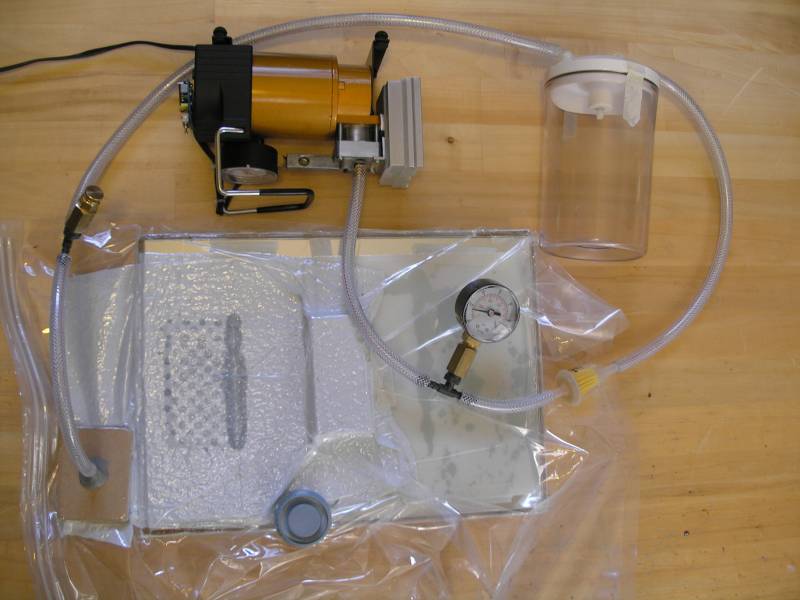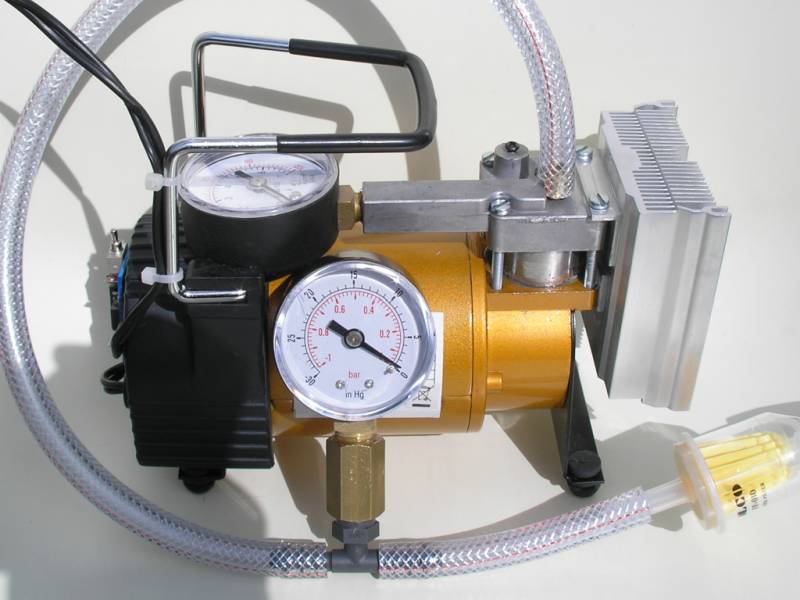Composites tips and info
- Intro
- Convert a low cost 12V air compressor into a vacuum pump
- Kevlar cutting with a cheap household shear
- Cheap vacuum seal storage bag for vacuum bagging
- High-stretch permanent vacuum bag
- DIY vacuum bag connector
- Saving vacuum bag sealant tape
- Create a dust-free room with a shower cabin
- Cleaning uncured epoxy with vinegar
- Using a cheap kitchen vacuum storage container as degassing vacuum chamber / resin catch pot
- Resin vacuum degasification tips
- Cheap precision scale for dosing resins
- Simple composite curing oven
- Using a mirror as substrate for making carbon sheets
- Bending uncured carbon plate
- Non-adhesive plastics for epoxy
- Cheap spray paint
- Useful websites and articles about composites
Intro
Making composite parts requires a lot of skill and experience. There is insufficient information available on the internet, you realize this when you start with composite manufacturing and things do not work out as you had seen on the Internet.
Here are some tips for making composite parts and ways that I have found to save costs. To be able to make professional composite parts, we need quite a lot of materials, health protection and mold making materials:

Convert a low cost 12V air compressor into a vacuum pump
See the article HERE.
Kevlar cutting with a cheap household shear

There are dedicated, very expensive, scissors for cutting Aramid fibers. But a new simple household shear of €1.25 also works, it will just wear faster.
Cheap vacuum seal storage bag for vacuum bagging
Vacuum bagging materials, such as sealing tape and bagging film, are rather expensive. Vacuum bagging film in a tube form has to be sealed at both ends, which cost a lot of gum tape. If stocks run out, it must be ordered again and shipping of composite materials is expensive because it are chemicals. So, I use vacuum seal storage bags with a ziplock which are reusable and don't need any gum tape.


These bags cost just €1.99 per three pieces. The vacuum bag is quick and easy to open and close. There are no serious leaks; furthermore, with the vacuum pump timer, small leaks are allowed.
High-stretch permanent vacuum bag
High-stretch vacuum foil works better with complex moulds and undercuts. To be able to reuse it many times, I glued it to a seal storage bag.


DIY vacuum bag connector
This connector, which has air slots, is made of MDF board. The hole is sealed with gum tape, which is reusable.



Saving vacuum bag sealant tape
Vacuum bag sealant tape is often wider than necessary. You can save tape by stretch it out to a width of 5mm, this may be enough:

Create a dust-free room with a shower cabin
A dust-free room for painting work can be created with a shower cabin. Before use, wet the walls and mist the shower cabin with a water spray bottle. Avoid dust by walking slowly and leaving the room after painting. Working with PVA needs special attention: the PVA may dry hardly because of the moisted shower cabin. Wait a few minutes until the PVA has flowed out and dry it with a heat gun.
 Use a shower cabin as dust-free room
Use a shower cabin as dust-free room
Cleaning uncured epoxy with vinegar
Vinegar has many uses. It is a culinary taste maker. It Removes lime scale from among others coffee makers. It is an effective glass cleaner. It is an effective rust remover. It will bring old paintbrushes back to life.
And vinegar is an excellent solvent for cleaning epoxy resin and hardener, even after the epoxy has begun to harden. Dip the dirty tools in a bowl with vinegar to clean them. You don't have to throw away laminating brushes anymore.

Using a cheap kitchen vacuum storage container as degassing vacuum chamber / resin catch pot
In the manufacturing of composites, vacuum chambers are used for:
- Resin degasification.
- Resin catch pot used with resin infusion.
- To set a lower vacuum, the vacuum pump must be switched off when the desired vacuum is achieved. Without vacuum buffer, this goes too fast to switch off timely; a vacuum buffer slows down the process.
- Vacuum buffer tank for "storing" vacuum.
Although a vacuum chamber is very simple, a professional vacuum chamber costs more than €100. So, I just use a kitchen vacuum storage container which works perfect. You can use the Solis vacuum box or the Vacuvin vacuum cereal saver.
There is something weird with a vacuum tank:
- It stores nothing.
- When the vacuum tank is full it is empty.


Resin vacuum degasification tips
- Degas the resin maximum 5 minutes
Degasification longer than 5 minutes could cause volatile constituents to escape that are needed for vulcanisation.
- Avoid vibration
The work table can vibrate due to the vacuum pump. This causes that the resin splashes around in the vacuum chamber. So, the vacuum pump should be kept away from the work table.
- Turn off the vacuum slowly
If after degassing, the air is let into the vacuum chamber too fast, the resin will splash around also.
Cheap precision scale for dosing resins
A precision scale is essential for dosing resins. This scale has a resolution of 0.01g and cost about €15. To protect against epoxy, cover it with adhesive plastic:
Simple composite curing oven
I made a composite curing oven out of a moving box, two 75W bulbs and a fan. Luckily, I have purchased a stock of bulbs because the sale will be prohibited in the future. The temperature is 60°C.


Using a mirror as substrate for making carbon sheets
A mirror can be used excellently to manufacture carbon fiber sheets.
- Dust particles are better visible than on an ordinary glass plate.
- The borders are smooth, so they don't damage the vacuum bag.
The mirror is glued with epoxy to an MDF board. The bottom is provided with breather / bleeder fabric:


Apply sufficient wax release agents layers, or use PVA.
Bending uncured carbon plate
A composite plate may be bent as long as it is not fully cured. By making use of this effect it is sometimes possible to fabricate composite parts in a simple way. Just a simple flat plate has to be manufactured, which then can be shaped into the desired form. Fixate the plate in the desired position for 12 hours until the epoxy has cured. The result is the best if the plate is not thicker than 0.5mm. Temporarily, the plate can be made soften with a heat gun. This method also can be used when a part has to fit exactly onto another part.
Non-adhesive plastics for epoxy
Low surface energy plastics are helpful as a substrate for composite fabrication, because they do not stick to epoxy.
Excellent non-adhesive properties
- Polyethylene. Applications: vacuum bagging film, construction film, plastic bags, pipes.
- Adhesive-backed mold release film / adhesive Teflon.
Moderate, can stick a little if no need release agent is used
- Polystyrene. Cheap material, applications: compact disc, disposable cups.
- Polypropylene. Has many applications, for instance gift wrapping foil.
- PET (Mylar)
- Acrylic glass (MPPA, Plexiglas)
Cheap spray paint
A plug should be sprayed several times with gloss paint to allow polishing. At the Action shop, a spray paint cost just €2. If you spray each layer in a different color, you have more control over the sanding.
Useful websites and articles about composites





